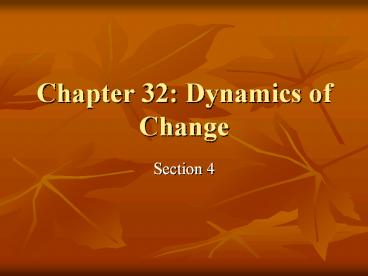Chapter 32: Dynamics of Change PowerPoint PPT Presentation
1 / 16
Title: Chapter 32: Dynamics of Change
1
Chapter 32 Dynamics of Change
- Section 4
2
Russian Expansion
- For centuries, Russian rulers have focused on war
and neglected agricultural developments. - 1500s, Ivan IV (Ivan the Terrible), expanded
eastward into Siberia and to the Pacific - Source of fur, farmland, and mineral resources
- Also a place for exiled political prisoners
- Russias campaign for a warm water port
- Peter the great conquered some of Sweden in the
Baltic - Catherine the Great conquered some of Poland,
Belarus, Lithuania, and some of the Ottoman
Empire near the Black Sea - Russia became a multinational nation which led to
conflict
3
(No Transcript)
4
Revolt and Repression
- Serfs wanted freedom and Nobles started to
embrace the Enlightenment and French Revolution. - Some hoped for a constitutional monarchy like
Great Britain - The Decembrist Revolt A small group of nobles
and army officers tried to over throw the Czar in
1825. Czar Nicholas I crushed the revolt, he
hung five leaders and exiled hundreds to Siberia - Czar Nicholas I, then banned liberal books,
imposed censorship, and spied on many
students/professors at universities - He tried to limit landlord powers over serfs but
it failed.
5
Decembrist Revolt
6
Anti-Semitism
- Jews suffered legal discrimination and the
government conducted pogroms, which are organized
acts of violence against Jews. - Jews were forced to live in certain areas and had
limited access to education and jobs. - Many Jews fled from Russia in the 1800s, many
sought refuge in Germany.
7
A Russian pogrom
8
Limited Reform
- By the 1800s, Russians started to realize that
their political system and economic system was
stagnating their countries growth. - The factories has labor shortages due to the fact
that serfs were bound to farms - 1861, Czar Alexander II freed the serfs and gave
them new political rights. - Citizens still lived in poverty due to debt and
high taxes.
9
Czar Alexander II freed the serfs
10
Effects of Industrialization
- The Middle Class grew and education spread
- Better health care and more food led to increased
population in the countryside - Land was scarce and living conditions worsened.
- Factory workers worked long days for little pay
and unions were banned by law. - Strikes and protests started to occur
11
Revolutionary Movements
- The rise of Socialism and Marxism
- Peasants should lead the revolution
- Wanted to end inequality and private ownership
- They assassinated Alexander II, which led to
suppression by the new Czar - Members moved toward fighting for factory workers
and rights for newly freed serfs
12
Karl Marx
13
Bloody Sunday
- 1904, Father Gapon led a march to Czar Nicholas
II and was met with heavy resistance - The marchers wanted better working conditions and
political freedoms - A hundred demonstrators were mowed down by
gunfire and many more were wounded - The protestors were shocked because they carried
portraits of the czar and were still attacked
14
Father Gapon
15
Revolution of 1905
- Riots broke out and the Czar formed a Duma, which
is an elected assembly - Despite these reforms the Czar was still an
autocratic ruler - Inequality remained and so did repression
- Peasants, national minorities, middle-class
liberals, and factory workers were still
disgruntled
16
A Modern Russian Duma

